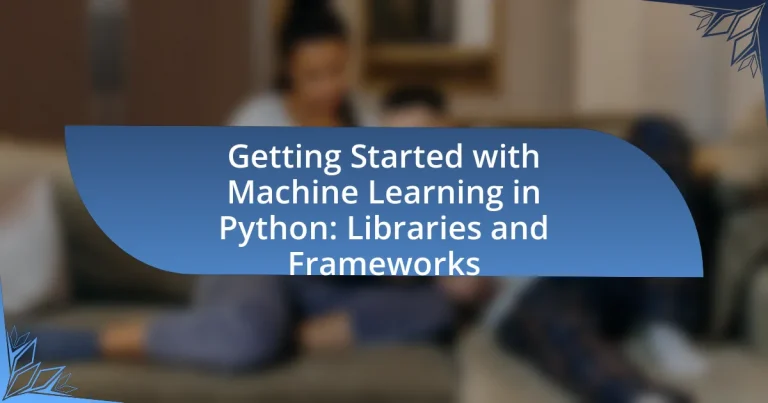Machine Learning is a crucial subset of artificial intelligence that allows systems to learn from data and enhance their performance without explicit programming. This article focuses on getting started with Machine Learning in Python, highlighting essential libraries and frameworks such as TensorFlow, PyTorch, and Scikit-learn. It covers key concepts like supervised, unsupervised, and reinforcement learning, as well as practical steps for setting up a Machine Learning environment, preparing data, and troubleshooting common issues. Additionally, it emphasizes best practices for model development and resources for continuous learning, providing a comprehensive guide for beginners and practitioners in the field.

What is Machine Learning and Why is it Important in Python?
Machine Learning is a subset of artificial intelligence that enables systems to learn from data and improve their performance over time without explicit programming. It is important in Python because Python offers a rich ecosystem of libraries and frameworks, such as TensorFlow, Scikit-learn, and PyTorch, which facilitate the development and deployment of machine learning models. These tools provide efficient implementations of algorithms, ease of use, and extensive community support, making Python a preferred language for data scientists and machine learning practitioners. The popularity of Python in this domain is evidenced by the TIOBE Index, which ranks Python as one of the top programming languages, largely due to its applications in machine learning and data analysis.
How does Machine Learning differ from traditional programming?
Machine learning differs from traditional programming in that it focuses on training algorithms to learn patterns from data rather than following explicit instructions coded by a programmer. In traditional programming, developers write specific rules and logic to solve problems, while in machine learning, models improve their performance through exposure to data, allowing them to make predictions or decisions based on learned experiences. This distinction is evident in applications such as image recognition, where machine learning models can adapt to new images without being explicitly programmed for each variation, demonstrating their ability to generalize from training data.
What are the key concepts of Machine Learning?
The key concepts of Machine Learning include supervised learning, unsupervised learning, reinforcement learning, features, models, and algorithms. Supervised learning involves training a model on labeled data to make predictions, while unsupervised learning deals with finding patterns in unlabeled data. Reinforcement learning focuses on training agents to make decisions through trial and error in an environment. Features are the input variables used for training models, and models are mathematical representations that learn from data. Algorithms are the procedures or formulas used to perform the learning tasks. These concepts form the foundation of Machine Learning, enabling various applications across industries.
Why is Python a preferred language for Machine Learning?
Python is a preferred language for Machine Learning due to its simplicity and extensive libraries. The language’s straightforward syntax allows developers to write and understand code quickly, which accelerates the development process. Additionally, Python boasts a rich ecosystem of libraries such as TensorFlow, Keras, and Scikit-learn, which provide pre-built functions and tools specifically designed for machine learning tasks. This extensive library support enables efficient implementation of complex algorithms and models, making Python a go-to choice for both beginners and experienced practitioners in the field of machine learning.
What are the main types of Machine Learning?
The main types of Machine Learning are supervised learning, unsupervised learning, and reinforcement learning. Supervised learning involves training a model on labeled data, where the algorithm learns to map inputs to outputs based on provided examples. Unsupervised learning, on the other hand, deals with unlabeled data, allowing the model to identify patterns and groupings without explicit instructions. Reinforcement learning focuses on training agents to make decisions by rewarding them for desirable actions and penalizing them for undesirable ones, often used in dynamic environments. These categories are foundational in the field of Machine Learning, guiding the development of algorithms and applications across various domains.
What is supervised learning and how does it work?
Supervised learning is a type of machine learning where a model is trained on labeled data, meaning that each training example is paired with an output label. The process involves feeding the model input data along with the corresponding correct output, allowing it to learn the relationship between the inputs and outputs. During training, the model adjusts its parameters to minimize the difference between its predictions and the actual labels, often using algorithms such as linear regression or decision trees. This method is validated through techniques like cross-validation, ensuring that the model generalizes well to unseen data. Supervised learning is widely used in applications such as image classification, spam detection, and medical diagnosis, demonstrating its effectiveness in solving real-world problems.
What is unsupervised learning and its applications?
Unsupervised learning is a type of machine learning where algorithms analyze and interpret data without labeled outcomes. This approach is used to identify patterns, group similar data points, and extract insights from datasets that lack predefined categories. Common applications of unsupervised learning include clustering, such as customer segmentation in marketing, and dimensionality reduction techniques like Principal Component Analysis (PCA) for data visualization. Additionally, it is utilized in anomaly detection to identify outliers in data, which is crucial in fraud detection and network security.
What is reinforcement learning and where is it used?
Reinforcement learning is a type of machine learning where an agent learns to make decisions by taking actions in an environment to maximize cumulative rewards. It is used in various applications, including robotics for autonomous navigation, game playing such as AlphaGo, and recommendation systems that adapt to user preferences. The effectiveness of reinforcement learning is evidenced by its success in complex tasks, demonstrated by systems like OpenAI’s Dota 2 bot, which learned to compete at a high level against human players.

Which Libraries and Frameworks are Essential for Machine Learning in Python?
The essential libraries and frameworks for machine learning in Python include TensorFlow, PyTorch, Scikit-learn, Keras, and Pandas. TensorFlow, developed by Google, is widely used for deep learning applications and offers robust tools for model building and deployment. PyTorch, favored for its dynamic computation graph, is popular in research and production for its flexibility. Scikit-learn provides simple and efficient tools for data mining and data analysis, making it ideal for traditional machine learning tasks. Keras, which runs on top of TensorFlow, simplifies the process of building neural networks. Pandas is crucial for data manipulation and analysis, allowing for easy handling of structured data. These libraries collectively support a wide range of machine learning tasks, from data preprocessing to model evaluation, making them indispensable in the Python ecosystem.
What are the most popular libraries for Machine Learning in Python?
The most popular libraries for Machine Learning in Python are TensorFlow, PyTorch, Scikit-learn, Keras, and XGBoost. TensorFlow, developed by Google, is widely used for deep learning applications and offers extensive tools for model building and deployment. PyTorch, favored for its dynamic computation graph, is popular in academia and research for its flexibility. Scikit-learn provides simple and efficient tools for data mining and data analysis, making it a go-to for traditional machine learning algorithms. Keras, which runs on top of TensorFlow, simplifies the process of building neural networks. XGBoost is renowned for its performance in structured data competitions, particularly in Kaggle. These libraries collectively dominate the Python machine learning landscape due to their robust functionalities and community support.
What functionalities does NumPy provide for Machine Learning?
NumPy provides essential functionalities for Machine Learning, including efficient array operations, mathematical functions, and linear algebra capabilities. These features enable the handling of large datasets and complex mathematical computations, which are fundamental in training machine learning models. For instance, NumPy’s n-dimensional arrays allow for efficient storage and manipulation of data, while its built-in mathematical functions facilitate operations like element-wise addition, multiplication, and statistical calculations. Additionally, NumPy supports linear algebra operations such as matrix multiplication and eigenvalue decomposition, which are crucial for algorithms like Principal Component Analysis (PCA) and neural network computations.
How does Pandas facilitate data manipulation in Machine Learning?
Pandas facilitates data manipulation in Machine Learning by providing powerful data structures like DataFrames and Series, which allow for efficient handling of large datasets. These structures enable users to perform operations such as filtering, grouping, merging, and reshaping data with ease. For instance, DataFrames support various data types and allow for intuitive indexing, making it simple to access and modify data. Additionally, Pandas includes built-in functions for handling missing data, which is crucial in preparing datasets for machine learning models. The library’s ability to integrate seamlessly with other libraries, such as NumPy and Matplotlib, further enhances its utility in the machine learning workflow, allowing for streamlined data analysis and visualization.
What role does Matplotlib play in visualizing Machine Learning data?
Matplotlib is a crucial library for visualizing Machine Learning data, as it provides a wide range of plotting functions that help in understanding data distributions, model performance, and relationships between variables. By enabling the creation of static, animated, and interactive visualizations, Matplotlib allows practitioners to effectively communicate insights derived from data analysis. For instance, it can be used to plot confusion matrices, ROC curves, and feature importance graphs, which are essential for evaluating model performance and making informed decisions. The library’s versatility and integration with other libraries, such as NumPy and Pandas, further enhance its utility in the Machine Learning workflow, making it an indispensable tool for data scientists.
What are the key frameworks for building Machine Learning models?
The key frameworks for building Machine Learning models include TensorFlow, PyTorch, and Scikit-learn. TensorFlow, developed by Google, is widely used for deep learning applications and offers robust tools for model deployment. PyTorch, created by Facebook, is favored for its dynamic computation graph and ease of use, particularly in research settings. Scikit-learn, a library built on NumPy and SciPy, provides simple and efficient tools for data mining and data analysis, making it ideal for traditional machine learning tasks. These frameworks are supported by extensive documentation and community contributions, ensuring their reliability and effectiveness in various machine learning projects.
How does TensorFlow support deep learning applications?
TensorFlow supports deep learning applications by providing a comprehensive ecosystem that includes flexible architecture, high-level APIs, and robust tools for model training and deployment. Its architecture allows users to build and train neural networks efficiently, utilizing both CPUs and GPUs, which enhances computational speed and scalability. TensorFlow’s Keras API simplifies the process of creating complex models with minimal code, making it accessible for developers at all skill levels. Additionally, TensorFlow includes TensorBoard for visualization, which helps in monitoring training progress and debugging models. These features collectively enable developers to implement state-of-the-art deep learning techniques effectively.
What advantages does PyTorch offer for Machine Learning projects?
PyTorch offers several advantages for Machine Learning projects, including dynamic computation graphs, ease of use, and strong community support. Dynamic computation graphs allow for flexible model building and debugging, enabling developers to modify the architecture on-the-fly, which is particularly beneficial for research and experimentation. The intuitive interface and Pythonic nature of PyTorch make it accessible for both beginners and experienced practitioners, facilitating rapid prototyping. Additionally, PyTorch has a robust ecosystem with extensive libraries and tools, such as TorchVision for computer vision tasks, which enhances its functionality. The active community contributes to a wealth of resources, tutorials, and pre-trained models, further accelerating development and deployment processes.
What is Scikit-learn and how is it used for model building?
Scikit-learn is an open-source machine learning library for Python that provides simple and efficient tools for data mining and data analysis. It is widely used for model building due to its comprehensive collection of algorithms for classification, regression, clustering, and dimensionality reduction, as well as utilities for model evaluation and selection. Scikit-learn’s user-friendly API allows developers to easily implement machine learning workflows, including data preprocessing, model training, and performance evaluation, making it a popular choice among data scientists and machine learning practitioners.

How to Get Started with Machine Learning in Python?
To get started with machine learning in Python, install essential libraries such as NumPy, pandas, scikit-learn, and TensorFlow. These libraries provide the foundational tools for data manipulation, analysis, and model building. For instance, NumPy offers support for large, multi-dimensional arrays and matrices, while pandas simplifies data handling and analysis. Scikit-learn is widely used for implementing machine learning algorithms, and TensorFlow is a powerful framework for deep learning. According to the 2023 Stack Overflow Developer Survey, Python remains the most popular programming language for machine learning, highlighting its extensive community support and resources.
What are the first steps to set up a Machine Learning environment in Python?
To set up a Machine Learning environment in Python, first install Python from the official website, ensuring you choose a version compatible with popular libraries. Next, install a package manager like pip, which typically comes with Python installations, to manage libraries efficiently. Following that, create a virtual environment using the command “python -m venv myenv” to isolate your project dependencies. Activate the virtual environment and then install essential libraries such as NumPy, pandas, scikit-learn, and TensorFlow using pip commands like “pip install numpy pandas scikit-learn tensorflow.” This setup allows for a structured and manageable environment for developing Machine Learning applications in Python.
How do you install essential libraries and frameworks?
To install essential libraries and frameworks for machine learning in Python, use the package manager pip. For example, you can install popular libraries such as NumPy, pandas, and scikit-learn by executing the command “pip install numpy pandas scikit-learn” in your terminal or command prompt. This method is widely accepted and documented in the official Python packaging guide, which states that pip is the standard tool for installing Python packages.
What tools can help in coding and testing Machine Learning models?
Python libraries and frameworks such as TensorFlow, PyTorch, Scikit-learn, and Keras are essential tools for coding and testing Machine Learning models. TensorFlow provides a comprehensive ecosystem for building and deploying ML models, while PyTorch is favored for its dynamic computation graph and ease of use in research. Scikit-learn offers a wide range of algorithms and utilities for data preprocessing and model evaluation, making it ideal for traditional machine learning tasks. Keras, which runs on top of TensorFlow, simplifies the process of building neural networks with its user-friendly API. These tools are widely adopted in the industry and academia, evidenced by their extensive documentation and community support, which facilitate effective model development and testing.
What are some best practices for developing Machine Learning models?
Best practices for developing Machine Learning models include data preprocessing, feature selection, model selection, hyperparameter tuning, and model evaluation. Data preprocessing ensures that the dataset is clean and formatted correctly, which is crucial as studies show that up to 80% of a data scientist’s time is spent on data cleaning. Feature selection helps in identifying the most relevant variables, improving model performance and interpretability. Model selection involves choosing the appropriate algorithm based on the problem type, with techniques like cross-validation aiding in this process. Hyperparameter tuning optimizes model performance by adjusting parameters that govern the learning process, often using grid search or random search methods. Finally, model evaluation through metrics such as accuracy, precision, recall, and F1 score provides insights into the model’s effectiveness, ensuring that it generalizes well to unseen data.
How do you prepare data for Machine Learning?
To prepare data for Machine Learning, one must follow a structured process that includes data collection, data cleaning, data transformation, and data splitting. Data collection involves gathering relevant datasets from various sources, ensuring they are representative of the problem domain. Data cleaning focuses on handling missing values, removing duplicates, and correcting inconsistencies to enhance data quality. Data transformation includes normalizing or standardizing numerical features and encoding categorical variables to make them suitable for algorithms. Finally, data splitting divides the dataset into training, validation, and test sets to evaluate model performance effectively. This systematic approach is essential, as studies show that up to 80% of a data scientist’s time is spent on data preparation, underscoring its importance in the Machine Learning workflow.
What techniques can improve model performance?
Techniques that can improve model performance include feature engineering, hyperparameter tuning, and ensemble methods. Feature engineering enhances model accuracy by transforming raw data into meaningful features, which can significantly impact performance. Hyperparameter tuning optimizes model parameters, leading to better fitting of the training data and improved generalization to unseen data. Ensemble methods, such as bagging and boosting, combine multiple models to reduce variance and bias, often resulting in superior predictive performance. These techniques are widely supported by empirical studies, demonstrating their effectiveness in various machine learning tasks.
What common challenges do beginners face in Machine Learning?
Beginners in Machine Learning commonly face challenges such as understanding complex algorithms, managing data preprocessing, and selecting appropriate models. The complexity of algorithms like neural networks can be overwhelming, as they require a solid grasp of mathematical concepts and programming skills. Data preprocessing is another significant hurdle; beginners often struggle with cleaning, normalizing, and transforming data to make it suitable for analysis. Additionally, selecting the right model for a specific problem can be confusing due to the vast array of options available, each with its own strengths and weaknesses. These challenges are well-documented in educational resources and studies, highlighting the steep learning curve associated with entering the field of Machine Learning.
How can you troubleshoot issues in model training?
To troubleshoot issues in model training, first, identify the specific problem by analyzing training logs and metrics. Common issues include overfitting, underfitting, and data quality problems. For instance, if the model performs well on training data but poorly on validation data, it may be overfitting, which can be addressed by using regularization techniques or simplifying the model architecture. Conversely, if the model performs poorly on both training and validation data, it may be underfitting, indicating the need for a more complex model or additional features. Additionally, ensure that the data is clean and properly preprocessed, as poor data quality can significantly impact model performance. Monitoring tools like TensorBoard can help visualize training progress and diagnose issues effectively.
What resources are available for continuous learning in Machine Learning?
Online courses, textbooks, and research papers are essential resources for continuous learning in Machine Learning. Platforms like Coursera, edX, and Udacity offer specialized courses from universities and industry leaders, covering various aspects of Machine Learning. Textbooks such as “Pattern Recognition and Machine Learning” by Christopher Bishop and “Deep Learning” by Ian Goodfellow provide foundational knowledge and advanced concepts. Additionally, research papers available on arXiv and Google Scholar keep learners updated on the latest advancements and methodologies in the field. These resources collectively support ongoing education and skill enhancement in Machine Learning.
What are practical tips for success in Machine Learning projects?
To achieve success in Machine Learning projects, it is essential to clearly define the problem and set measurable goals. This foundational step ensures that the project remains focused and aligned with business objectives. Additionally, selecting the right dataset is crucial; high-quality, relevant data significantly impacts model performance. According to a study by Domingos (2012) in “A Few Useful Things to Know About Machine Learning,” data quality often outweighs algorithm choice in determining success.
Moreover, employing a systematic approach to model selection and evaluation, such as cross-validation, helps in understanding model robustness. Utilizing established libraries and frameworks like TensorFlow or Scikit-learn can streamline development and provide access to optimized algorithms. Regularly iterating on the model based on feedback and performance metrics is also vital, as it allows for continuous improvement.
Lastly, fostering collaboration among team members with diverse expertise enhances problem-solving capabilities and innovation, as highlighted in research by Kahn et al. (2018) in “The Role of Team Diversity in Machine Learning Projects.” These practical tips collectively contribute to the successful execution of Machine Learning projects.


